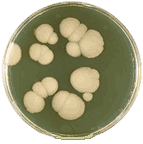Papers in the Biological Sciences
Date of this Version
7-2016
Document Type
Article
Citation
Published in Algal Research 18 (2016), pp 332–340. doi 10.1016/j.algal.2016.06.001
Abstract
Most animal–microbe symbiotic interactions must be advantageous to the host and provide nutritional benefits to the endosymbiont. When the host provides nutrients, it can gain the capacity to control the interaction, promote self-growth, and increase its fitness. Chlorella-like green algae engage in symbiotic relationships with certain protozoans, a partnership that significantly impacts the physiology of both organisms. Consequently, it is often challenging to grow axenic Chlorella cultures after isolation from the host because they are nutrient fastidious and often susceptible to virus infection. We hypothesize that the establishment of a symbiotic relationship resulted in natural selection for nutritional and metabolic traits that differentiate symbiotic algae from their free-living counterparts. Here, we compare metabolic capabilities of 5 symbiotic and 4 free-living Chlorella strains by determining growth levels on combinations of nitrogen and carbon sources. Data analysis by hierarchical clustering revealed clear separation of the symbiotic and free-living Chlorella into two distinct clades. Symbiotic algae did not grow on nitrate but did grow on two symbiont-specific amino acids (Asn and Ser) on which the free-living strains did not grow. The use of these amino acids was exclusively affected by the presence/absence of Ca2+ in the medium, and the differences were magnified if galactose was provided rather than sucrose or glucose. In addition, Chlorella variabilis NC64A genomic and differential expression analysis confirmed the presence of abundant amino acid transporter protein motifs, some of which were expressed constitutively both axenically and within the host. Significantly, all 5 symbiotic strains exhibited similar physiological phenotypes even though they were isolated as symbionts from different host organisms. Such similarities indicate a parallel coevolution of shared metabolic pathways across multiple independent symbiotic events. Collectively, our results suggest that physiological changes drive the Chlorella symbiotic phenotype and contribute to their natural fitness.
Includes Supplementary materials.
Included in
Computational Biology Commons, Environmental Microbiology and Microbial Ecology Commons, Genomics Commons, Marine Biology Commons, Molecular Genetics Commons, Other Genetics and Genomics Commons, Other Life Sciences Commons, Pathogenic Microbiology Commons, Plant Pathology Commons


Comments
Copyright © 2016 Elsevier B.V. Used by permission.